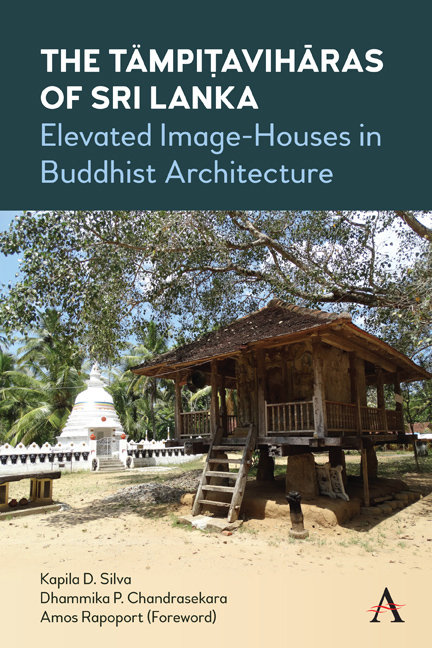Chapter 3 - The Evolution of Ṭämpiṭavihāras and Their Variations
Published online by Cambridge University Press: 16 December 2021
Summary
The Emergence of the Ṭämpiṭavihāra
The lack of archaeological evidence for image-houses belonging to the post-Polonnaruva era up to the late Kandyan period has led to speculations that the ṭämpiṭavihāra is a unique type of image-house and a deviation from the earlier paṭimāghara tradition. Although most ṭämpiṭavihāras now in use were originally built in the second half of the eighteenth century, supplementary architectural and literary evidence indicate that the ṭämpiṭavihāra tradition dates from the thirteenth century (the post-Polonnaruva era). Furthermore, it seems that the tradition of constructing timber image-houses on stone columns – the key characteristic of ṭämpiṭavihāras – was the popular norm after the thirteenth century, while those of brick construction, such as those in the earlier Polonnaruva, were the exception.
As cited above, in the days of the earliest paṭimāgharas between the fifth and ninth centuries, a tiled-andtimber-framed roof on stone pillars with brick walls encasing the framed structure was the construction method in vogue. The stone columns supported the roof and braced the brick walls that subdivided the interior of the shrine; thus, the brick walls did not necessarily support the roof. No specific evidence has been found of multi-storey image-houses in the Anurādhapura period, although ecclesiastical buildings, upōsathāghara such as the Lōhapāsāda of the third century with timber floors supported on stone columns, existed (Silva 1988, 193– 95). This tradition continued even during the Polonnaruva period, amidst high popularity of brick construction. The most significant examples are the two tooth-relic temples – Aṭadāgē and Häṭadāgē – two-storied monuments that housed relics on the upper floor and were built with timber decks on stone pillars, while the lower level functioned as an image-house. The same method was used to construct the timber galleries in the brickvaulted geḍigēs of Polonnaruva. Furthermore, in and around the metropolis of Polonnaruva were many multi-storied image-houses (Basnayake 1986, 5), which might have used the same construction method. This was revived later in the wake of the much-celebrated brick geḍigē style of the Polonnaruva era. Although the ṭämpiṭavihāras of the eighteenth century varies from these pre-thirteenth century image-houses in many respects, the tradition of erecting storied paṭimāgharas with timber floors supported on stone columns was widely in practice before the Kandyan period.
- Type
- Chapter
- Information
- The Tämpitaviharas of Sri LankaElevated Image-Houses in Buddhist Architecture, pp. 55 - 66Publisher: Anthem PressPrint publication year: 2021

